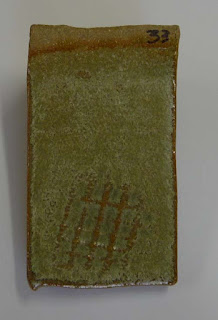Unfortunately its still not over at that point. Some of the components, particularly the clays, don't suspend easily in water and so every blend has to be pushed through a fine screen to get good mixing and acceptable suspension of the components.
I also used some brushing medium this time too - a commercial liquid product - which I added at a rate of about one quarter of the added liquid. It certainly seemed to make a big difference in getting a smooth and even surface with three or four coats of glaze applied by brush. Either that or I'm just climbing the learning curve, but I'll certainly use it again.
The other interesting discovery has been the value of texture in the surface of the clay. I formed the test pieces by rolling under a piece of canvas and so the surface while flat was not smooth. It was a pretty tight canvas weave and so the texture was still pretty 'fine'. This meant that the finite differences in depth of the glaze on the surface that result from brushing was compounded by the canvas texture. The net result was a level of fine mottling which gives interest and visual appeal to the surface. This is definitely something I'm going to try to replicate on pots in the future.
In this series of tests I also tried a few overlays - one glaze brushed over the top of another. This was a bit of a blind activity not having any tangible confirmation at the time of what the basic glazes would look like. I did get one that produced a result in the target zone. More work to be done on this opportunity.
The following pictures are of the top selections of the individual glaze recipes which I will now use for bonsai pots. It's good to be able to go to that next step now with a higher level of confidence in the outcome. The other really useful outcome is that I now have a number of base glazes which reliable give me a matte/satin finish and that I can now work with to further develop colouration variations.
Thes are all brush applied, 4 coats and then oxidation fired to 1240C.
Number 26 is a nice satin red/brown.
This one, number 30, has 50% Nephyline Syenite which is more suited to the 1240 firing temperature than something like Custer Feldspar. Good olive green satin.
The base for this glaze is from one called Val's Satin Black. Thanks Val. I've reduced the Si/Al ratio to go further down the spectrum and have got good surface and colour variagation.
Number 39 uses the same base as John Post's Tomato Red glaze, also a Nephylene Syenite glaze. This has produced a good matte/satin blue with 0.5% Cu carb and 1% Co carb.
Number 43 is also based on a John Post formulation - this one his high calcium matte formulation, again Nephyline Syenite. This one shows most clearly the impact of the underlying 'canvas' surface texture. I ran a series if these using the same base which has just 3% Titanium Oxide for added opacifier. I'm going to run some again and make them a little more opaque and up the colourant addition to make them a little stronger, most have turned out very pastel toned.
This one, number 68 is based on Sankey's Iron Red glaze with added 8% Zinc Oxide. This is a custer glaze base.
I found a straight Butterscotch recipe which I ran with Kaolin as a substitute for Ball Clay to cut the silica and it produced a very nice satin butterscotch yellow. Number 74 uses the same base and otherwise 2% Manganese carbonate for the brown.
Number 77 is derived from a classic Nutmeg Shino recipe and shows a good mottle. I like it even if the surface is a touch glossier than I'd aimed for.
This one is a classic Tenmoku formula, tweaked to give a satin finish. Clearly with some underlying surface texture the surface colour variations are very interesting.
And this last one is a layered glaze. As testament to the unpredictability of this technique the underlying glaze is an iron rich shino overlayed with a reasonably fluid, fairly transparent blue /green glaze. It has a great mottled surface which doesn't have much to do with the stoneware surface.










No comments:
Post a Comment
Happy to hear your advice, feedback or questions